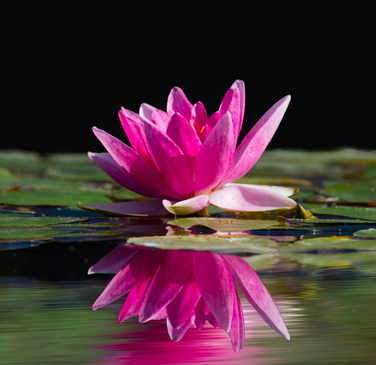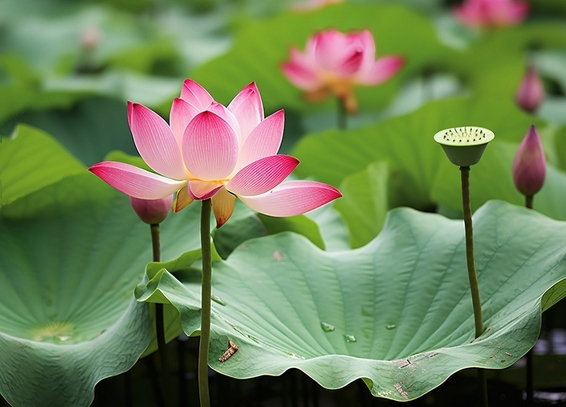Water Lilies (Nymphaeaceae) are a family of aquatic plants known for their striking beauty and floating flowers. These plants are often associated with serene ponds and lakes, making them a popular feature in gardens and natural water bodies. Water lilies are celebrated for their round, floating leaves and large, colorful blossoms that bloom above the water’s surface.
1. Botanical Characteristics
- Leaves (Lily Pads): Water lily leaves are circular, leathery, and float on the surface of the water. They have a waxy coating that repels water, allowing them to stay buoyant. The leaves vary in size, with some reaching up to 30 cm in diameter.
- Flowers: Water lily flowers are large, fragrant, and come in a variety of colors, including white, pink, yellow, purple, and blue. The flowers are often star-shaped with multiple petals and float on or slightly above the water surface. They typically open in the morning and close in the evening.
- Roots: Water lilies are anchored to the bottom of the water body through long stems and tuberous roots. The roots are submerged in the soil or mud at the bottom, while the leaves and flowers float on the water surface.
- Growth Habitat: Water lilies grow in calm, shallow waters, typically ponds, lakes, and slow-moving rivers. They thrive in full sunlight and need a stable water environment with a depth of 30 to 90 cm.
2. Species of Water Lilies
There are around 70 species of water lilies, categorized into two main groups: hardy water lilies and tropical water lilies.
- Hardy Water Lilies: These species are cold-tolerant and can survive in temperate climates. They bloom during the day and are available in a range of colors, including white, pink, red, and yellow. Examples include Nymphaea odorata and Nymphaea alba.
- Tropical Water Lilies: These species prefer warmer climates and tend to have more vibrant colors, including blues and purples. Some tropical varieties bloom at night, such as Nymphaea caerulea and Nymphaea lotus.
3. Ecological Importance
- Oxygen Production: Like many aquatic plants, water lilies contribute to the oxygenation of water, making the environment healthier for fish and other aquatic organisms.
- Habitat and Shelter: Water lily leaves (lily pads) provide shelter and shade for aquatic life, including fish, frogs, and small insects. They help regulate the water temperature and offer protection from predators.
- Water Filtration: The roots of water lilies help filter the water by absorbing nutrients from the soil and water, which can prevent the growth of algae and other harmful microorganisms.
4. Cultural and Symbolic Significance
- Art and Literature: Water lilies have been a source of inspiration for artists, poets, and writers. Perhaps the most famous depiction of water lilies in art is Claude Monet’s “Water Lilies” series, which captures their beauty in Impressionist style.
- Religious Symbolism: In various cultures, water lilies symbolize purity, enlightenment, and rebirth. In ancient Egypt, the blue water lily (Nymphaea caerulea) was associated with the sun god Ra and symbolized the cycle of life, death, and rebirth.
- Cultural Uses: The tubers and seeds of certain species, like the lotus, have been used for food in traditional cultures. In Hindu and Buddhist cultures, water lilies are often used in religious rituals and as offerings.

5. Cultivation and Care
Water lilies can be cultivated in water gardens, ponds, and even large containers. Here are the key care tips for growing water lilies:
- Planting Depth: Water lilies should be planted in containers submerged 30-90 cm deep, depending on the species. Containers should be filled with clay or loamy soil, and the roots should be buried deep in the soil to anchor the plant.
- Sunlight: Water lilies need at least 4-6 hours of direct sunlight each day to bloom properly. Insufficient light can result in fewer or no flowers.
- Water Conditions: The water should be calm and still, as water lilies do not thrive in moving water. The ideal water temperature for tropical species is around 21-30°C, while hardy species can tolerate cooler temperatures.
- Fertilization: Fertilizing water lilies during the growing season will help promote healthy leaves and abundant blooms. Fertilizer tablets can be placed directly into the soil around the roots.
- Pruning and Maintenance: Remove dead or decaying leaves and flowers regularly to prevent rot and algae growth. Hardy species may need to be pruned back before winter to prepare for dormancy.
6. Threats and Conservation
Although water lilies are widely cultivated and grow abundantly in the wild, some species face threats due to habitat destruction, pollution, and invasive species. For instance, excessive water pollution can lead to eutrophication, which diminishes oxygen levels in water and harms aquatic plants like water lilies. In some regions, invasive species such as water hyacinth compete with native water lilies for resources, threatening their survival.
7. Interesting Facts about Water Lilies
- Victoria Amazonica: This is the largest species of water lily, native to the Amazon River basin. Its leaves can grow up to 3 meters in diameter, and they are strong enough to support the weight of a small child.
- Night-blooming Water Lilies: Some tropical species bloom at night and close during the day. This is an adaptation to attract nocturnal pollinators like moths and bats.
- Ancient Origins: Fossil records suggest that water lilies have existed for at least 130 million years, making them some of the oldest flowering plants on Earth.
8. Conclusion
Water lilies are not only admired for their striking beauty but also play a vital ecological role in freshwater ecosystems. Their elegant flowers and floating leaves have captivated people for centuries, symbolizing tranquility and purity. Whether in a natural pond or a home water garden, water lilies bring a sense of serenity and natural beauty to aquatic environments.


